Vertamotion™
Spinal Motion Measurement
Device
In addition to devices for
dynamic stabilization of the spine, Orthonex is also developing minimally-invasive
diagnostic devices that can provide Neurosurgeons and Orthopedic Surgeons
with objective, quantitative, and precisely-controlled clinical information
concerning each of the multiple dimensions of spinal movement. This
information can help Neurosurgeons and Orthopedic Surgeons to decide which
therapeutic approach is optimal for each patent.
Currently, surgeons have
to make clinical decisions with limited objective quantitative information
concerning the multiple dimensions of spinal movement. There is no
currently-available minimally-invasive device that provides surgeons with
objective, quantitative, and precisely-controlled clinical information
concerning each of these multiple dimensions: spinal flexion, extension,
lateral bending, decompression, compression, and torsion. As a result,
there is considerable subjectivity in assessing a patient's range of spinal
motion in order to determine the best therapeutic course of action for
a particular patient. Not surprisingly, there is tremendous variation
in practice patterns concerning which therapies are chosen for which conditions.
It is unlikely that quality is being optimized and that risks and costs
are being optimally controlled with such subjective assessment and such
high variation in practice patterns.
To address this unmet clinical
need, Dr. Hart Garner, a Board-Certified Neurosurgeon, invented Orthonex's
patent-pending Vertamotion™ spinal motion measurement device. The
Vertamotion™ device, which is still under development and not yet approved
by the FDA for patient care, has the potential to provide surgeons with
objective, quantitative, and precisely-controlled clinical information
concerning each of the multiple dimensions of spinal movement: flexion,
extension, lateral bending, decompression, compression, and torsion.
This information can help surgeons to select the optimal therapeutic approach
for each patent, improving the quality of care, reducing risk, and managing
costs.
Orthonex's patent-pending
Vertamotion™ spinal motion measurement device includes rods that are inserted
into two or more spinal vertebrae in a minimally-invasive manner.
These rods are then automatically moved to cause and measure spinal flexion,
extension, lateral bending, decompression, compression, or torsion.
With the Vertamotion™ device, each of these dimensions of movement can
be independently and precisely controlled. The resulting quantitative
information concerning spinal motion can be analyzed to determine the optimal
therapeutic approach for a particular patient. Advantages of the
Vertamotion™ device over earlier approaches include: objective and quantitative
information concerning spinal motion dynamics; independent control and
measure of flexion, extension, lateral bending, decompression, compression,
or torsion, without confounding by multiple types of movement; and minimally-invasive
spinal motion control and measurement without the need for invasive tissue
removal.
As one example of how the
Vertamotion™ device may be applied, a surgeon may have to decide whether
or not to implant stabilization hardware to provide stabilization to support
spinal fusion. If the objective analysis of spinal motion provided
by this device indicates that the vertebrae are sufficiently stable on
their own, then stabilization hardware may not need to be implanted.
As another example, a surgeon may have to decide whether or not to replace
a natural intervertebral disc, which may have become dysfunctional, with
an artificial intervertebral disc. If the objective analysis of information
provided by this device indicates that the natural intervertebral disc
is doing a good job of resisting compression, then an artificial intervertebral
disc may not need to be implanted. As another example, if the results
of this device indicate asymmetry in spinal range of motion, then asymmetric
dynamic stabilization of the spine may be appropriate.
Figure 1 shows one example
of how the Vertamotion™ device may be designed. This example includes
four rods whose distal ends have been minimally-invasively inserted into
the spinal vertebrae. The rods are threaded to enable tapping
into pedicles in a manner analogous to the manner used for pedicle screws.
The proximal ends of the rods extend into a control unit. This control
unit exerts forces on the rods, in a manner that enables full control over
the angle of each rod, and then measures the resulting movement of the
vertebrae in response to these forces. The motion-analyzing
program in the control unit analyzes the relationship between the forces
that are applied to the vertebrae through the rods and the resulting movement
of the vertebrae. Analysis of this relationship can help to guide
the selection of a therapeutic approach from among different therapeutic
approaches such as exercise, dynamic stabilization of the spine, and spinal
fusion.
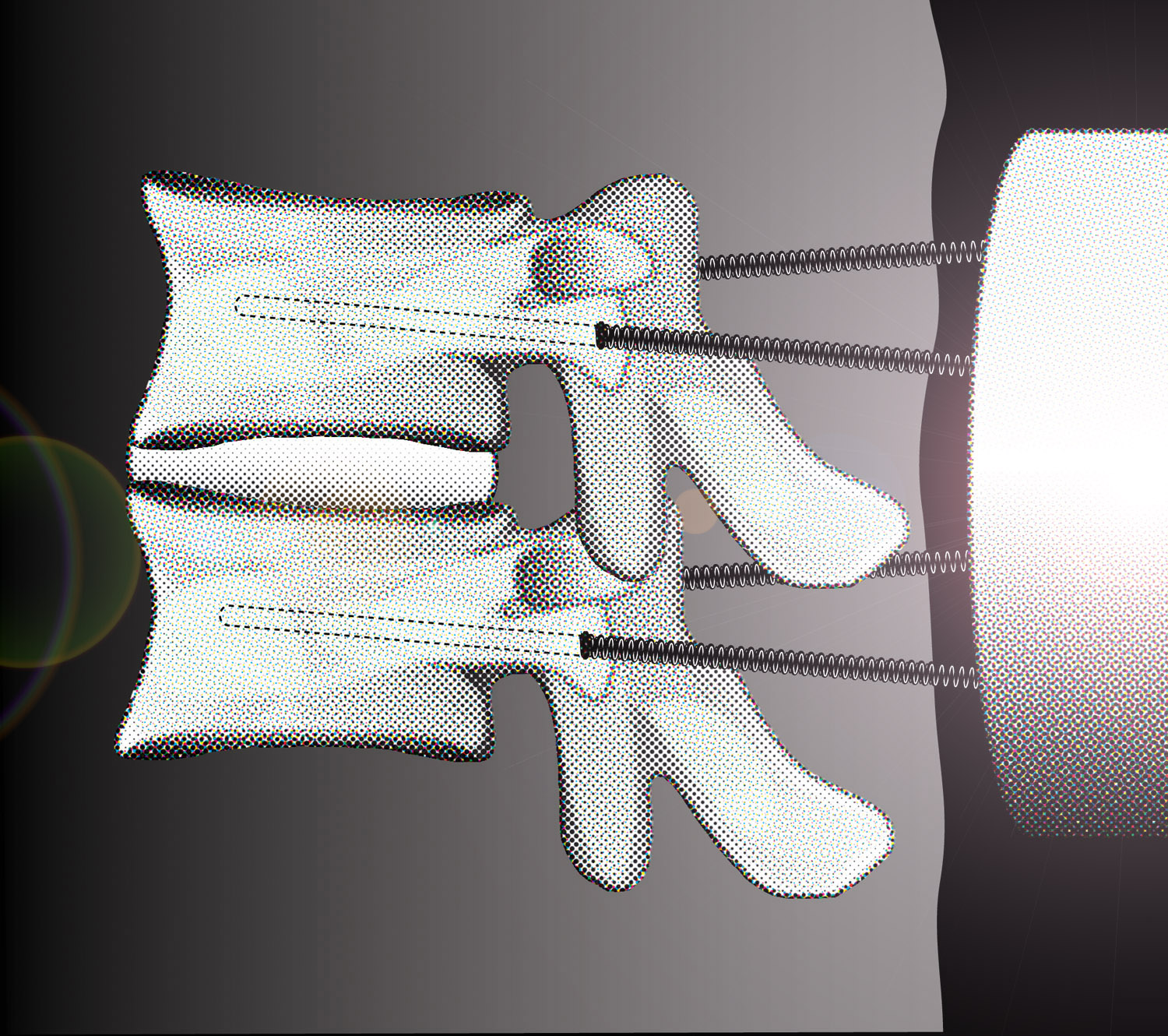
Figure 1: Vertamotion™
Spinal Motion Measurement Device
in Baseline Position
In the example shown in Figure
1, the four rods have been inserted into the body in a minimally-invasive
percutaneous manner with x-ray assistance through small openings in the
tissue of the patient's back. Insertion of the rods is guided from
the surface tissue into the pedicles via x-ray imaging. The rods
may then be manipulated within the control unit by electric actuators,
hydraulic actuators, pneumatic actuators, or other means.
Spinal movements are often
categorized into flexion, extension, lateral bending, decompression, compression,
and torsion. These movements may be informally defined as follows:
spinal flexion is "bending forward"; spinal extension is "bending backwards";
spinal lateral bending is "bending to the right or left"; spinal decompression
is "vertical elongation"; spinal compression is "vertical shortening" of
the spine; spinal torsion is "vertical twisting." However, these
informal definitions are not sufficiently precise for our purposes.
These informal definitions are inadequate for isolating these movements
from each other. In earlier devices, these individual movements are
either confounded or not measured at all. For these reasons, we now
present more formal and precise definitions of spinal flexion, extension,
lateral bending, decompression, compression, and torsion.
Spinal flexion may be formally
defined as spinal movement that changes a linear angle formed by the intersection
of the lateral cross-sectional planes of two vertebrae, wherein the vertex
of this angle is anterior to the center of the vertebrae. The amount
of flexion is the degree of the linear angle formed by the intersection
of the lateral cross-sectional planes of two vertebrae, wherein the vertex
of this angle is anterior to the center of the vertebrae.
Spinal extension may be formally
defined as spinal movement that changes a linear angle formed by the intersection
of the lateral cross-sectional planes of two vertebrae, wherein the vertex
of this angle is posterior to the center of the vertebrae. The amount
of extension is the degree of the linear angle formed by the intersection
of the lateral cross-sectional planes of two vertebrae, wherein the vertex
of this angle is posterior to the center of the vertebrae.
Spinal lateral bending may
be formally defined as spinal movement that changes a linear angle formed
by the intersection of the lateral cross-sectional planes of two vertebrae,
wherein the vertex of this angle is to the right or left of the center
of the vertebrae. The amount of lateral bending is the degree of
the linear angle formed by the intersection of the lateral cross-sectional
planes of two vertebrae, wherein the vertex of this angle is to the right
or left of the center of the vertebrae.
Spinal decompression may
be formally defined as spinal movement that increases the average distance
between all points in the lateral cross-sections of two spinal vertebrae.
Spinal compression may be formally defined as spinal movement that decreases
the average distance between all points in the lateral cross-sections of
two spinal vertebrae. Spinal torsion may be formally defined
as spinal movement that rotates the lateral cross-sectional plane of one
vertebra around the vertical axis of the vertebra relative to the cross-sectional
plane of a second vertebra.
Figure 2 shows the same example
of the Vertamotion™ device that was shown in Figure 1, except that now
the angles of the four rods have been adjusted by the control unit in order
to cause and measure flexion of the spinal vertebrae. The control
unit analyzes the relationship between the forces applied to the vertebrae
by the rods and the resulting flexion of the vertebrae. The results
of this analysis are then used by a surgeon in order to guide selection
of a therapeutic approach. Figure 3 shows the same example,
but for extension of the spinal vertebrae.
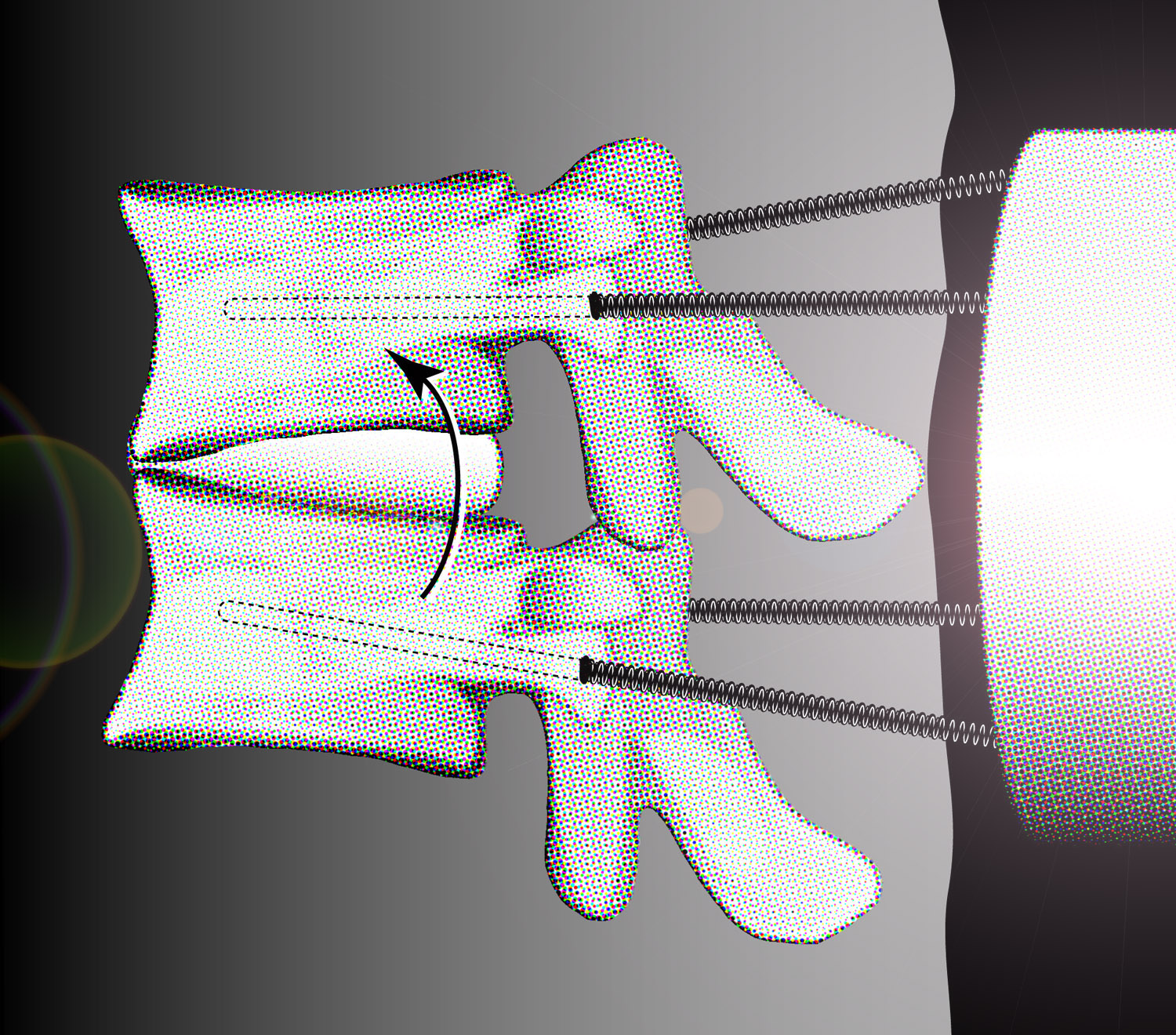
Figure 2: Vertamotion™
Spinal Motion Measurement Device
During Controlled Flexion
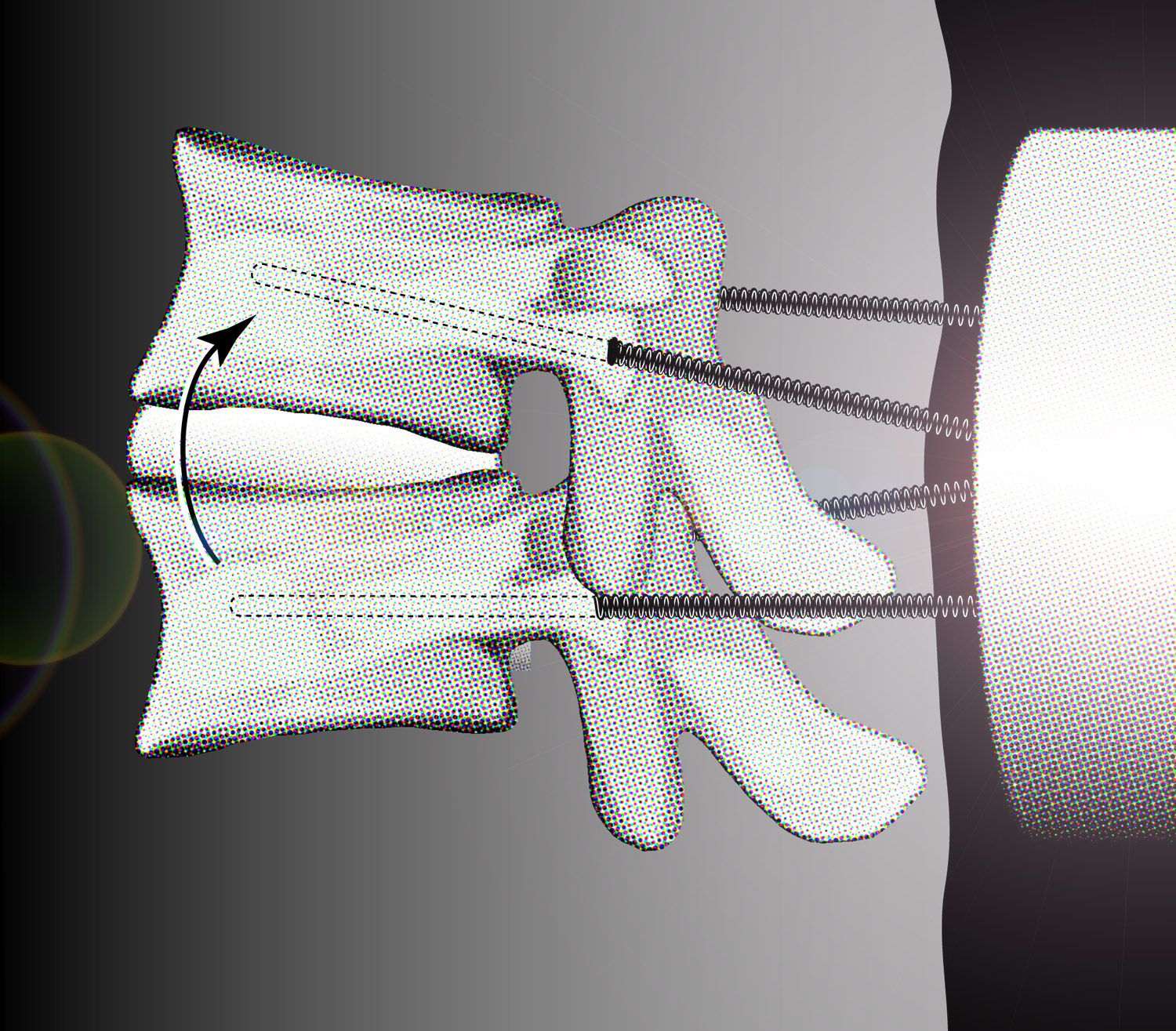
Figure 3: Vertamotion™
Spinal Motion Measurement Device
During Controlled Extension
Figure 4 shows the same example
of the Vertamotion™ spinal motion measurement device that was shown
in Figure 1, except that now the two pairs of two rods have been separated,
in a manner that maintains their parallel configuration, in order to cause
and measure pure decompression. Measurement of pure compression
is not possible with earlier devices without invasive removal of tissue,
such as to insert a device into the intervertebral space. Also, application
of expansive forces to a single points on each vertebrae, as in some earlier
devices, causes motion that confounds decompression with flexion. Figure
5 shows the same example, but for spinal compression. Figure 6 shows
the same example, but with the Vertamotion™ device causing and measuring
spinal torsion.
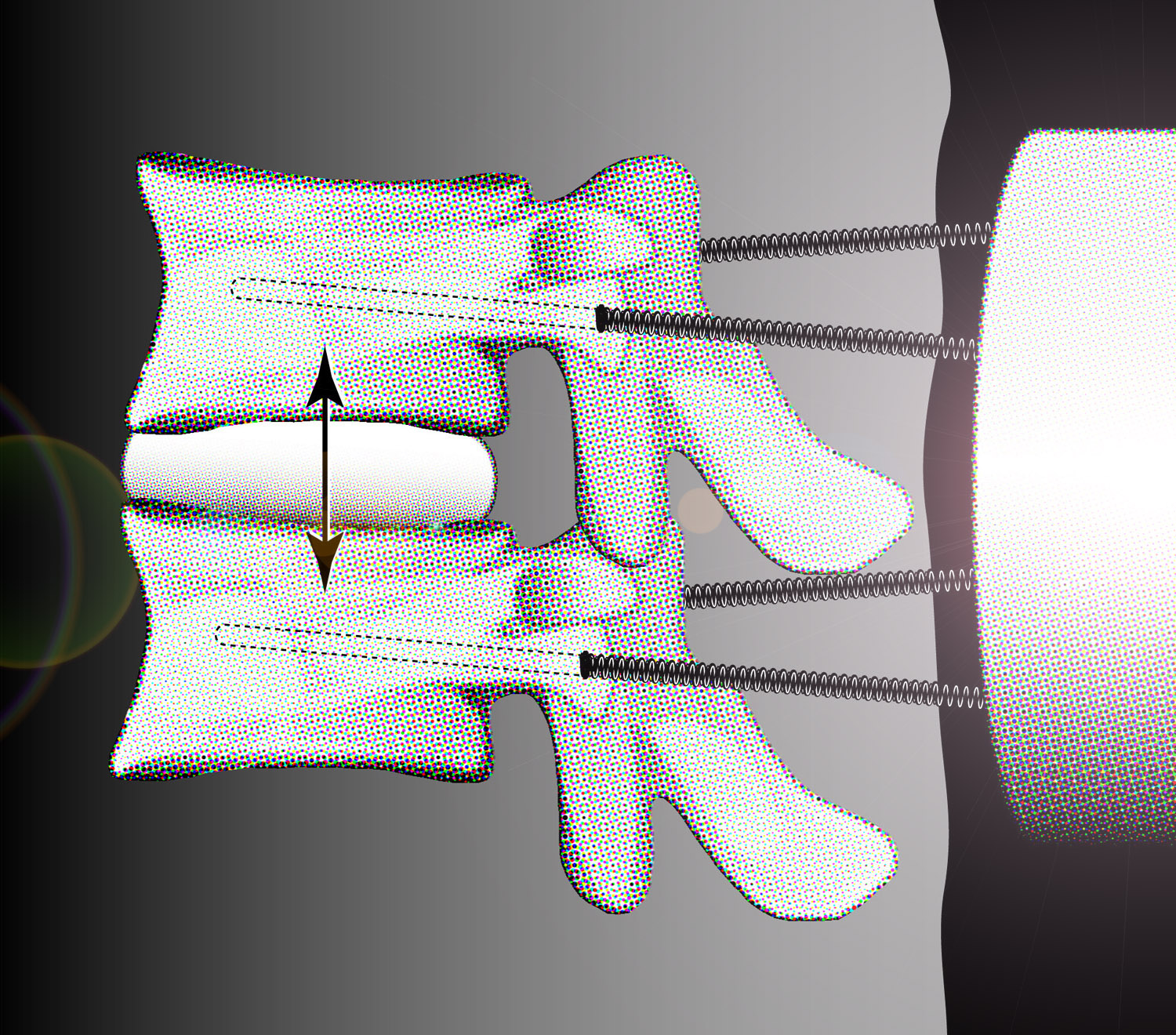
Figure 4: Vertamotion™
Spinal Motion Measurement Device
During Controlled Decompression
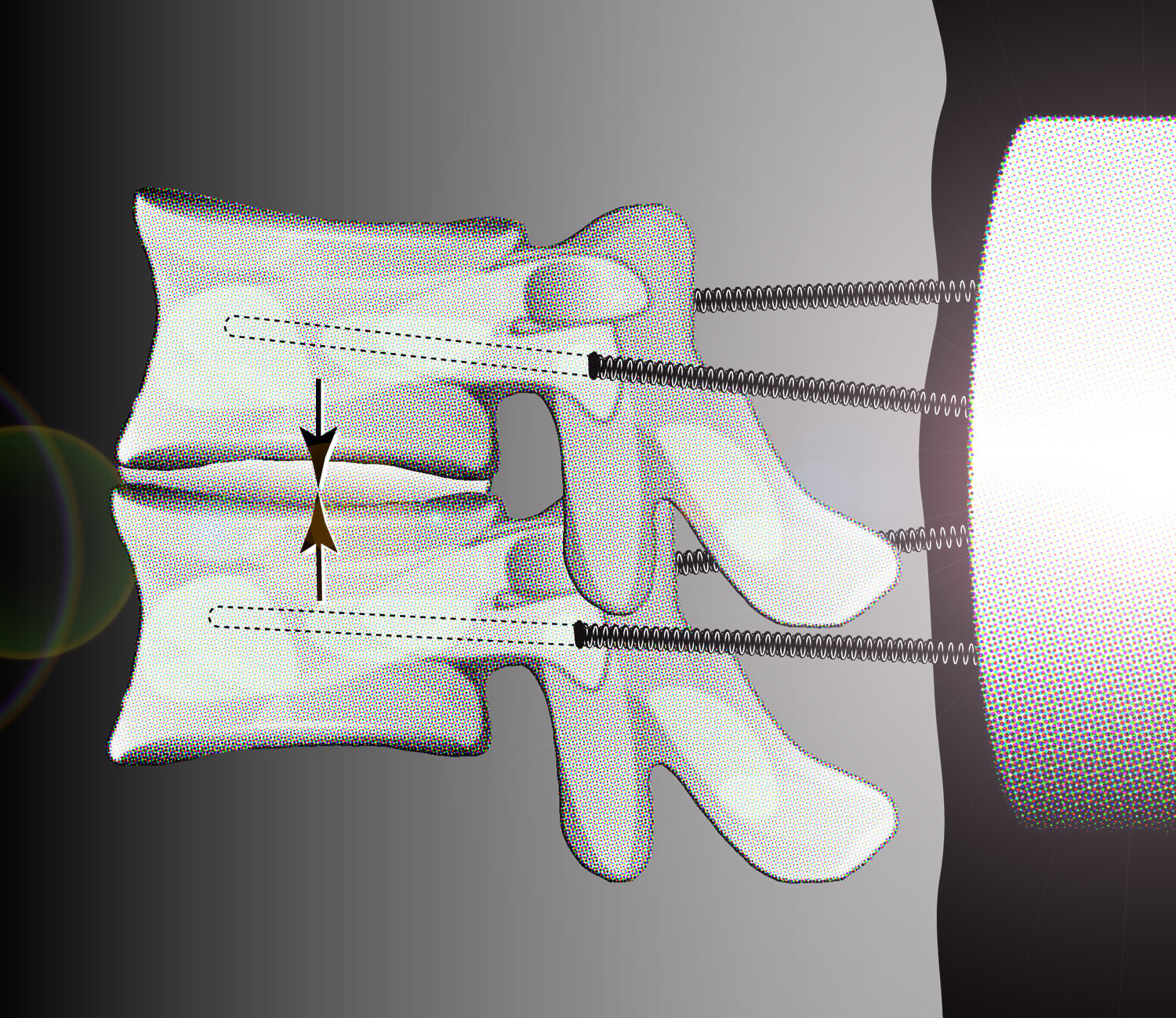
Figure 5: Vertamotion™
Spinal Motion Measurement Device
During Controlled Compression
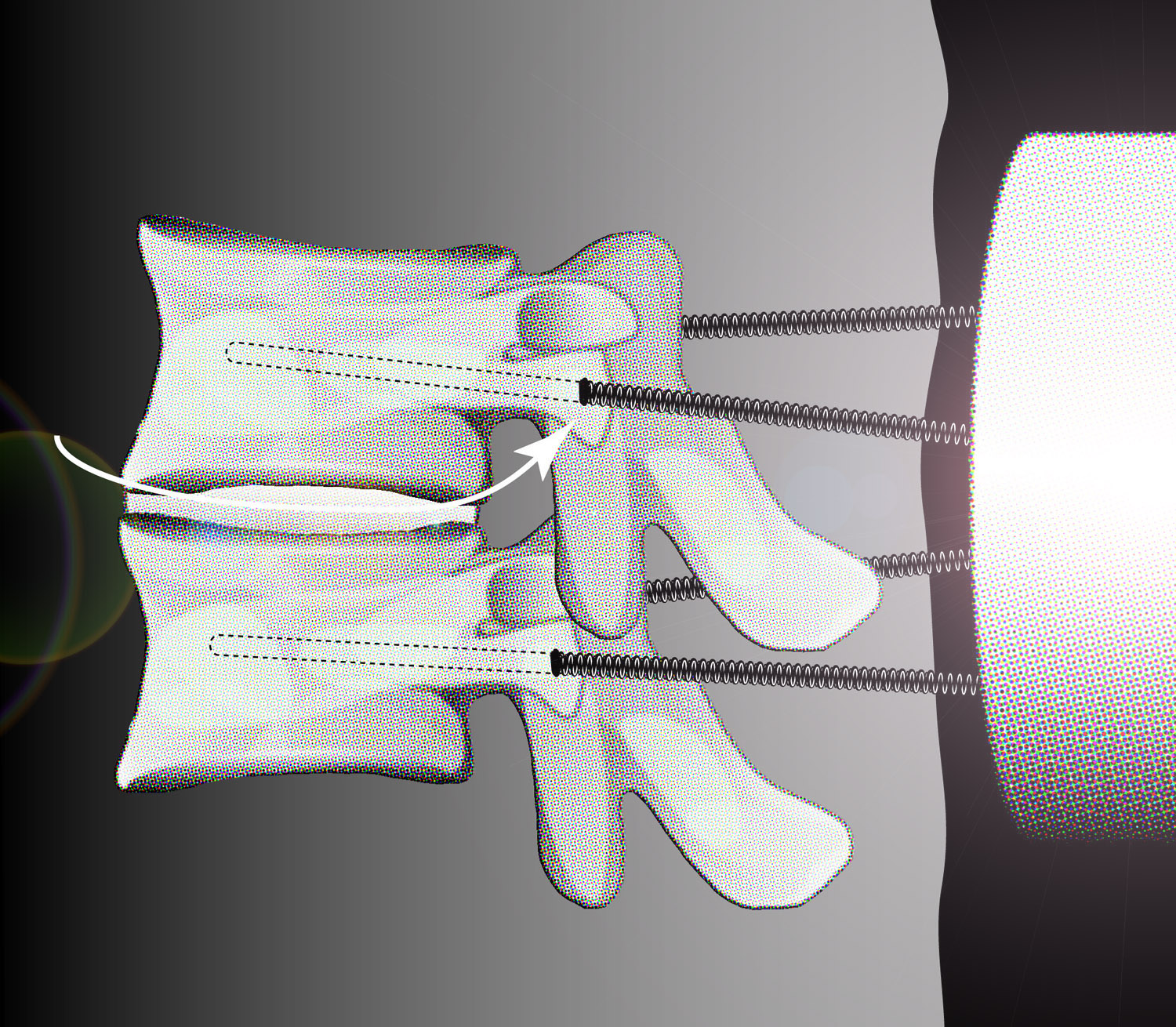
Figure 6: Vertamotion™
Spinal Motion Measurement Device
During Controlled Torsion
To summarize, Orthonex's
Vertamotion™ device for measuring spinal motion is a minimally-invasive
device that can provide surgeons with objective, quantitative information
concerning spinal flexion, extension, lateral bending, decompression, compression
and torsion in order to select the best therapeutic course of action for
each patient. This information can help surgeons to select
the optimal therapeutic approach for each patient, to improve the quality
of care, and to reduce the risk and expense of unnecessary spinal procedures
and hardware. Orthonex's Vertamotion™ device is under development
and is not yet approved by the FDA for use in patients. |